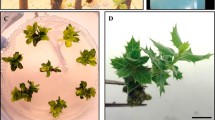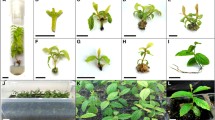Abstract
This paper describes research on the application of tissue culture techniques to the micropropagation of cork oak (Quercus suber L.), a forest species of ecological and industrial importance in the Mediterranean area. Apical buds and nodal stem segments were employed as initial explants. Their origins were young seedlings, stump sprouts and sprouts formed on cuttings collected from old trees.
The action of the mineral medium and growth regulators was studied in the multiplication stage. Media with low concentrations of ions, such as Sommer's or Heller's, are more suitable for growth and proliferation of explants than other media richer in salts. It was also observed that cytokinin (BA) must be present for the culture development. Adding low concentrations of auxin (NAA) to the medium improves the multiplication rate, especially in vegetative material of adult origin.
The auxin type is the most important factor in the promotion of rhizogenesis. The method of application determines the quality of the root system. Treatment with low concentrations of IBA added to the rooting medium gives the best results.
High sucrose concentration also improves rooting. Diluting the mineral rooting medium is slightly favourable, although there is no significant difference between it and the standard mineral concentration.
Similar content being viewed by others
Abbreviations
- D:
-
Durzan's
- GD:
-
Gresshoff & Doy's
- H:
-
Heller's
- L:
-
Lepoivre's
- MS:
-
Murashige & Skoog's
- SH:
-
Schenk & Hildebrandt's
- S:
-
Sommer's medium
References
Bellarosa R (1981) In vitro culture of Quercus suber L. embryos. Proc Coll Int sur la Culture in vitro des Essences Forestières. IUFRO (AFOCEL, Ed) Fontainebleau, France (pp 119–25)
Chalupa V (1984) In vitro propagation of oak (Quercus robur L.) and linden (Tilia cordata Mill.). Biol Plant 26: 374–7
Durzan DJ, Chafe SC, Lopushanski SM (1973) Effects of environmental changes on sugars, tannins, and organized growth in cell suspension cultures of White Spruce. Planta 113: 241–249
Gresshoff PM, Doy CH (1972) Development and differentiation of haploid Lycopersicum esculentum. Planta 107: 161–70
Haissig BE (1974) Origins of adventitious roots. NZ J For Sci 4: 290–310
Heller R (1983) Rocherches sur la nutrition minérale des tissus végétaux cultivés in vitro. Annales de Sci Nat (Bot) Biol Végétale 14: 1–223
Jaquiot C (1952) Sur les phénoménes d'histogenése observés dans des cultures in vitro de tissu cambial de chênes (Quercus sessiflora Sm., Q. pedunculata Ehrh., Q. suber L.). Acad Sci 234: 1468–70
Lane WD (1978) Regeneration of apple plants from shoot meristem-tips. Plant Sci Lett 13: 281–285
Maataoui M El, Espagnac H (1987) Neoformation of somatic embryo-like structures from cork-oak (Quercus suber L.) tissue cultures. CR Acad Sci Ser III, Vol 304, No 3, Jan 21: 83–88
May JM (1952) Extended and corrected tables of the upper percentage points of the studentized range. Biometrika 39: 192–3
Murashige T, Skoog F (1962) A revised medium for rapid growth and bioassays with tobacco tissue culture. Physiol Plant 15: 473–497
Pardos JA (1981) In vitro plant formation from stem pieces of Quercus suber L. Coll Int sur la Culture in vitro des Essences Forestiéres. IUFRO (AFOCEL, Ed) Fontainebleau, France (186–190)
Quoirin M, Lepoivre P (1977) Etude de milieux adaptés aux cultures in vitro de Prunus. Acta Hortic 78: 437–42
San José MC, Vieitez AM, Vieitez E (1985) Establecimiento y multiplicación in vitro de brotes del género Quercus. FYTON 45: 31–40
Schenk RV, Hildebrandt AC (1972) Medium and techniques for induction and growth of monocotyledonous and dicotyledonous plant cell cultures. Can J Bot 50: 199–204
Seckinger GR, McCown BH, Struckmeyer BE (1979) Production of anomalous structures in Quercus rubra L. callus cultures. Amer J Bot 66: 993–996
Skirvin RM, Chu MC, Rukan H (1980) Rooting studies with Prunus sp. in vitro. HortScience 15: 83–415
Sommer HE, Brown CL, Kormanik PP (1975) Differentiation of plantlets in longleaf pine (Pinus palustris Mill.) tissue cultured in vitro. Bot Gaz 136: 196–200
Thorpe TA (1982) Carbohydrate utilization and metabolism. In: Bonga JM, Durzan DJ (Eds) Tissue Culture in Forestry. Martinus Nijhoff Publ, Dordrecht (pp 325–368)
Vieira Natividade J (1950) Subericultura. Ministerio de Economia, Direçao dos Servicios Forestais e Aquicolas. Lisboa
Vieitez AM, San José MC, Vieitez E (1985) In vitro plantlet regeneration from juvenile and mature Quercus robur L. J Hortic Sci 60: 99–106
Author information
Authors and Affiliations
Rights and permissions
About this article
Cite this article
Manzanera, J.A., Pardos, J.A. Micropropagation of juvenile and adult Quercus suber L.. Plant Cell Tiss Organ Cult 21, 1–8 (1990). https://doi.org/10.1007/BF00034484
Received:
Accepted:
Issue Date:
DOI: https://doi.org/10.1007/BF00034484




